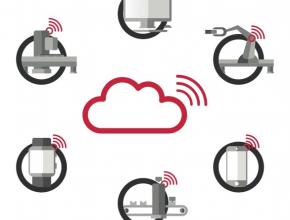At last year's major trade fairs, including Ligna, AWFS, and WMS, every major equipment and software provider touched on the subject of Industry 4.0. At an ever-increasing pace, this technology is transforming almost everything in our life, at home and at work. Internet based businesses are taking market share from the traditional “brick & mortar” businesses. The Internet of Services (IoS) and the Internet of Things (IoT) are also affecting our industry.
Industry 4.0, also referred to as “The Connected Factory”, will transform the woodworking and furniture industry, the same way it will bring change to any other industry. We believe the only choice we have is whether we are leaders and early adopters, or late adopters. There is no waiting on the sidelines until this “fad” is over. The elements of the revolutionary game changers are available and need to be applied and integrated.
Industry 4.0 is not a product you can buy and install. It is a term for internet-based technology that you can apply in your organization. It does not replace good engineering and solid organization; It allows you to grow more effectively.
The subject of Industry 4.0 is complex and just one, or a series of articles, would not cover all of what needs to be understood and addressed. Industry 4.0 touches all aspects of the business so, in order to prepare for The Connected Factory, we need to look at all facets of the company.
In earlier articles we explained in more detail the origin of the term Industry 4.0 or the Fourth Industrial Revolution. The term "Industry 4.0" is only about 8 years old. The main characteristics for Industry 4.0 strategy are - strong customization of products under the conditions of highly flexible (mass-) production. This simple description also describes the key challenges faced by the woodworking and furniture industry for decades. Wikipedia describes it as “…the required automation technology is improved by the introduction of methods of self-optimization, self-configuration, self-diagnosis, cognition and intelligent support of workers in their increasingly complex work…” Many elements of providing Industry 4.0 solutions pre-date the official start. Industry 4.0, the Smart Factory, or the Connected Company are all synonyms for a very lofty goal.
As much as Industry 4.0 is about leading-edge technology and the internet, it is also about the alignment, integration and connection of all business processes within a company. At Lignum Consulting, we have identified 7 key areas that all need to be addressed in order to get your company prepared. The areas are interconnected and need to be aligned:
• Strategy
• Product
• Logistics
• Data integration
• Organization
• Human Resources
By analyzing and evaluating these seven subjects, you create a snapshot of where the company is now. Gaps will show up, and future investments can be evaluated on the impact they make on this score card. In previous articles we focused on Strategy, Product and Technology (machines) and (internal) Logistics. In today’s article we will do a deep dive on Data Integration.
Product offering drives the need
The main driver for your data requirements is the complexity and the variants of the product offering. If the product offering is small and rigid, the bill of materials can be simple and rigid. The complexity of data systems increases significantly with the complexity of the product offering.
All production information for standard products are readily available. Any modification of a standard product can not be managed by the system and requires manual insertion of processes. The system does not know the status and location of a specific order. Manual expediting, hand-written lists, and operator calculated dimensions are the requirement.
In the next stage (I would estimate that most companies fit into this category), the existing ERP / Engineering system created the required information/data for all standard products, and typical, repeating product variants are automatically generated and provided. However, the data generation is not for all products. Custom products still need to be controlled by manual intervention. As soon as these manual interventions are required the current system is no longer efficient. Their system has information on the location in the factory and process status of most of the production parts and products.
Here is an example of the inherent complexity in the kitchen cabinet industry:
If a standard base cabinet is offered with 3 case finishes (i.e. white, hard maple and plywood) on the interior, and 4 versions on the outside (right, left, or both ends matching the front finish, or just matching the interior finish) we now have 12 versions. The case/box might have an integrated base or adjustable legs (2 options). The doors are hinged either left or right. The front variation can be in solid wood (4 species x 5 styles x 10 finishes), painted (i.e. MDF) doors, 6 styles with 6 standard colors, or Thermofoil doors with 5 styles and 6 different foils.
You offer three types of drawer boxes (melamine, metal and solid wood dove-tailed). On hardware you offer soft-close and standard hinges and slides, and you top it up with 12 different options of handles or knobs. Multiplying these options will result in 450,000 (give or take a few thousand) different combinations. These options are for just one cabinet in your catalog. If you are a semi-custom cabinet manufacturer, you probably find the above assumptions conservative. As a semi-custom or custom manufacturer, you entertain almost unlimited size variations and custom styles, finishes and materials and even drive the complexity a few notches higher.
Cabinet manufacturing itself is not very difficult. What is difficult is managing the variety of product and managing the information from what the customer wants to what the worker and the machine must produce. Integrating the data, seamlessly from order entry to manufacturing (and beyond) is the challenge.
The ultimate goal is that all data required for production and processing is created automatically, is order related and in real time, to all workplaces and machines. Because there is no differentiation between “Standard” and “Custom”, the information flows unimpeded and automatically. No manual interferences or corrections are required. Monitoring of the production progress allows the ability of locating and availability check at anytime by the system or the operator.
Where are you in this progression?
Data integration guarantees the continuous flow of information along the entire value chain.
The questions that need to be addressed: Are the existing IT systems aligned to each other? Is data redundancy avoided? Is the data system integrated from order entry to invoicing (beginning to end)?
All these questions need to be asked on the following subjects:
Machine / System Integration: Is equipment supplied on a timely basis with all required data?
Have fully integrated data interface to machines or complex machine lines within the overall process developed and established?
As machines and machine controllers are supplied from different manufacturers with their own multi-generation and/or proprietary software/platforms, the interfacing is even more complex. Integrability and compatibility are becoming more important than the individual machine performance.
Process Data Model: Is there a defined process data model?
The process data model includes:
- Manufacturing model and organizational loops (manufacturing-to-stock (MTS), manufacturing-to-order (MTO), assembly-to-order(ATO))
- Assembly on article basis and machining on parts or component basis
- Production scheduling related to factory thru-put time and capacity planning
- Ability for different Bill of Material (BOM) rules to generate lists and data for different production reasons
- Data transfer via defined interfaces, i.e., for generating machine programs
- Data generation for internal and external logistic systems
Information Flow: Is there an interconnected, integrated, automated data flow from dealer to factory to final consumer?
One-time data entry, data generation and data processing for all process steps in the company, starting with graphic order design at dealer or sales department, order entry, production, and shipping, customer service and installation, all the way to invoicing and accounts receivable.
Synchronized Production: Are all processes of the company aligned to customer takt-time?
All processes in the company are aligned and balanced. Bottlenecks are identified and managed.
Customer Order, Product and Material Requirement Planning: Are there distinct Order Entry, Production, and Material Requirement Planning modules with connectivity in functional interfaces?
The core objectives of Production Planning are:
- Definition of individual orders
- Capacity planning and capacity monitoring
- Planning of internal and external material volume
- Combining of individual customer orders for production work orders to smooth production requirements
- Release of production orders
Interfaces: Does a uniform database allow bi-directional communication between functional modules without creating media breaks?
All data interfaces should be identified and fully defined. Media breaks must not exist and there should be no redundancy of data.
Product Configuration: Are there rule-based product configurations?
Only with suitable product configurators can we manage the extreme product variety described above.
Product configuration:
Rule-based and automatic configuration of complex products based on product features, options, and technical details, with integrated limits and cross-checks.
Graphic product configuration:
Enhancement of the product configuration with either additional graphic data or additional alpha-numeric product definitions.
Conclusion
This subject of Data Integration shows more than any of the other 6 elements how interconnected the implementation of any improvement is. No single department can establish a plan without aligning it with all the other departments. As the requirements of all the elements converge at data integration, it is necessary that knowledge holders and visionaries from all functional groups evaluate their need and create a mutually agreed upon strategy. We will continue to write about Industry 4.0 and the seven key areas of Industry 4.0. The next article will focus on Organization in the Connected Factory. We welcome and encourage your feedback, and you can reach us at [email protected].
 Georg Frey
Georg Frey Sepp Gmeiner
Sepp GmeinerAbout the authors
Georg Frey is the president of Lignum Consulting. Sepp Gmeiner is a partner at Lignum Consulting. They can be reached at [email protected].






Have something to say? Share your thoughts with us in the comments below.